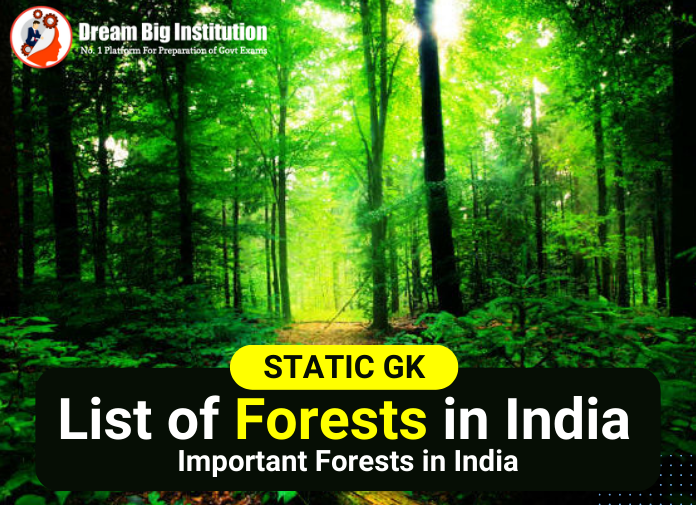Table of Contents
List of Forests in India
Forests in India State Wise: The list of Important Forest In India is a very important topic for competitive exams. General Awareness/ Static GK for Banking and other competitive exams like SSC, NABARD, RBI, IBPS, SBI, PGDBF, Railways, and Insurance exams requires knowledge of many different subjects, one such subject is List of Important Forest In India.
Today, we provide you with a concise List of Important forests in India. This List of Important Forest In India is important and useful for upcoming competitive exams. As per previous years’ exam trend, 1-2 questions are generally asked from this topic so we have compiled the List of Important Forests In India.
List Of Forests in India state wise
We depend on the forests for our survival, from the air we breathe to the wood we use. Besides providing habitats for animals and livelihoods for humans, forests also provide watershed protection, prevent soil erosion and mitigate climate change. Yet, despite our dependence on the forests, we are still allowing them to disappear.
List of Reserve Forest Reserves in India
| No | Forest Name | Forest Location |
|---|---|---|
| 1 | Kaziranga National Park | Assam |
| 2 | Jim Corbett National Park | Uttarakhand |
| 3 | Ranthambore National Park | Rajasthan |
| 4 | Manas National Park | Assam |
| 5 | Dudhwa National Park | Uttar Pradesh |
| 6 | Nagarhole National Park | Karnataka |
| 7 | Pench National Park | Madhya Pradesh |
| 8 | Sanjay Gandhi National Park | Mumbai |
| 9 | Periyar National Park | Kerala |
| 10 | Eravikulam National Park | Kerala Munnar |
| 11 | Namdapha National Park | Arunachal Pradesh |
| 12 | The Great Himalayan National Park | Himachal Pradesh |
| 13 | Bhagwan Mahaveer Sanctuary | Goa |
| 14 | Sundarban National Park | West Bengal |
| 15 | Simlipal National Park | Orissa |
| 16 | Guindy National Park | Chennai |
| 17 | Bhitarkanika National Park | Odisha |
| 18 | Rajaji National Park | Uttarakhand |
| 19 | Panna National Park | Madhya Pradesh |
| 20 | Keibul Lamjao National Park | Manipur |
| 21 | Silent Valley National Park | Kerala |
| 22 | Sariska Tiger Reserve Alwar | Rajasthan |
| 23 | Pilibhit Tiger Reserve | Uttar Pradesh |
| 24 | Turahalli Forest | Bangalore |
| 25 | Dr Salim Ali Bird Sanctuary | Goa |
| 26 | Orang National Park | Guwahati |
| 27 | Khangchendzonga National Park | Sikkim |
| 28 | Bandipur Tiger Reserve | Bangalore |
| 29 | Buxa Tiger Reserve | West Bengal |
| 30 | Pobitora Wildlife Sanctuary | Assam |
| 31 | Coringa Wildlife Sanctuary | Andhra Pradesh |
| 32 | Wayanad Wildlife Sanctuary | Kerala |
| 33 | Parambikulam Tiger Reserve | Kerala |
| 34 | Kanha Tiger Reserve | Madhya Pradesh |
| 35 | Satpura Tiger Reserve | Madhya Pradesh |
| 36 | Chinnar Wildlife Sanctuary | Kerala |
| 37 | Gir National Park | Gujarat |
| 38 | Bhadra Wildlife Sanctuary | Karnataka |
| 39 | Sultanpur National Park | Haryana |
| 40 | Betla National Park | Jharkhand |
List of Important Forests In India
| S.No | Name | Location | Notes |
| 1 | Abujmarh forest | Chhattisgarh | The Abujhmarh forest is spread over 1,500 square miles in the Bastar region of Chhattisgarh.It is home to indigenous tribes of India, including Gond, Muria, Abuj Maria, and Halbaas. |
| 2 | Annekal Reserved Forest | Western Ghats | Annekal Reserved Forest is a protected area in the Western Ghats, India. |
| 3 | Baikunthapur Forest | Dooars, West Bengal | The Baikunthapur forests are situated in the Terai region of western Dooars/Duars within the state of West Bengal. |
| 4 | Bhavnagar Amreli Forest | Gir National Park, Amreli district, Gujarat | Bhavnagar Amreli Forest is a reserved area for conservation of Asiatic lions. |
| 5 | Bhitarkanika Mangroves | Odisha | The Bhitarkanika Mangroves are a mangrove wetland in India’s Odisha state.In 1975, an area of 672 km2 was declared the Bhitarkanika Wildlife Sanctuary.The core area of the sanctuary, with an area of 145 km2, was declared Bhitarkanika National Park in September 1998.The Gahirmatha Marine Wildlife Sanctuary, which bounds the Bhitarkanika Wildlife Sanctuary to the east, was created in September 1997 |
| 6 | Dvaita Forest | Thar Desert | The Dvaita Forest or Dvaitavana was situated to the south of the Kamyaka Forest.It contained within it a lake called the Dwaita lake, abounding with flowers, and delightful to look at, and inhabited by many species of birds, elephants and many trees (3,24).It was on the south-western outskirts of Kurujangala and thus the whole of the Kuru Kingdom.It was situated near the borders of the desert (northern extension of the Thar desert into Haryana) (3,176).It also lay on the banks of the Saraswati River (known there as the Bhogavati). |
| 7 | Jakanari reserve forest | Coimbatore | This forest is in the foothills of Jakanari mountain of Nilgris.Jaccanaire reserve forest/Jakanari is a reserve forest in north of Coimbatore where Forest College and Research Institute is situated.This reserve forest is recently becoming polluted because of human activities of nearby Mettupalayam. |
| 8 | Kamyaka Forest | Kuru Kingdom along the banks of the Sarasvati River | Kamyaka Forest is mentioned in the Indian Epic “Mahabharata” being situated at the head of the Thar Desert, near the Trinavindu Lake.It contained within it a lake called the Kamyaka lake (2,51). |
| 9 | Kukrail Reserve Forest | Lucknow, Uttar Pradesh | The Kukrail Reserve Forest was planted in the 1950s over 5000 acres to serve as the city’s green lungs. |
| 10 | Madhu Forest | Northern India, west of Yamuna | According to the Ramayana, an Asura named Madhu, ruled this forest and its territory. |
| 11 | Molai forest | Jorhat district, Assam | Molai forest is named after Padma Shri Jadav “Molai” Payeng, Indian environmental activist and forestry worker. |
| 12 | Mulai Kathoni | Brahmaputra River, Assam | Molai forest is a forest on Majuli district in the Brahmaputra River near Kokilamukh, Assam. |
| 13 | Naimisha Forest | Gomati River, between the Panchala Kingdom and Kosala Kingdom, Uttar Pradesh | Naimisha Forest or Naimiṣāraṇya was an ancient forest mentioned in the Mahabharata and the puranas. |
| 14 | Nallamala Hills | Eastern Ghats, Andhra Pradesh (South of River Krishna) | The Nallamala Hills is bordered by two major rivers Krishna and Pennar.Nestled in the Nallamala Ranges of Eastern Ghats, the Nagarjunasagar Srisailam Tiger Reserve (NSTR) is a repository of Biodiversity and an abode for endangered flora and fauna. |
| 15 | Nanmangalam Reserve Forest | Chennai,Tamilnadu | Nanmangalam Reserve Forest is a protected forest located in Chengalpattu district, about 24 km from the city centre. |
| 16 | New Amarambalam Reserved Forest | The Western Ghats | Amarambalam Reserve Forest is one of the largest reserve forests of Kerala.The Indian Bird Conservation Network (IBCN) has identified 212 species of birds from the Nilambur and Amarambalam forests |
| 17 | Pichavaram Mangrove Forest | Cuddalore District, Tamil Nadu | World’s second biggest mangrove forest. |
| 18 | Saranda forest | West Singhbhum district, Jharkhand | Saranda is Asia’s largest Sal Forest.Sal (Shorea robusta) is the most important tree in the area. |
| 19 | Vandalur Reserve Forest | Chennai, Tamilnadu | Vandalur Reserve Forest is a protected area located in the suburb of Vandalur in the southwestern part of Chennai, about 30 km from the city centre.In 1976, a portion of the reserve forest covering 1,265 acres (512 ha) was demarcated by the Tamil Nadu Forest Department as the new location for the Madras Zoo, |
What are the different types of forests in India?
Coniferous Forests, Broadleaved Forests, Evergreen Forests, Wet Evergreen, Deciduous Forests, and Mangrove Forests are some main types of forests found in India. Total Forest and Tree Cover rises to 24.56% of the total geographical area of India. In this article, we have published the properties of the types of forests in India.
India has a diverse range of forests: from the rainforest of Kerala in the south to the alpine pastures of Ladakh in the north, from the deserts of Rajasthan in the west to the evergreen forests in the north-east. Climate, soil type, topography, and elevation are the main factors that determine the type of forest. Forests are classified according to their nature and composition, the type of climate in which they thrive, and their relationship with the surrounding environment.
Types of Indian Forests
Indian forests perform an important role to make a healthy environment and it reduce air pollutions. As of 2021, the total forest cover in India is 713,789 Sq km, which is 21.71 percent of the total geographical area. These forests can be classified in five major groups namely:
1. Moist tropical forest
2. Dry tropical forest
3. Montane temperate forest
4. Montane sub tropical forest
5. Alpine forest
Forest Types in India:
a) Coniferous Forests grow in the Himalayan mountain region, where the temperatures are low. These forests have tall stately trees with needlelike leaves and downward-sloping branches so that the snow can slip off the branches. They have cones instead of seeds and are called Gymnosperms.
b) Broadleaved Forests have several types, such as evergreen forests, deciduous forests, thorn forests, and mangrove forests. Broadleaved forests have large leaves of various shapes.
c) Evergreen Forests grow in the high rainfall areas of the Western Ghats, North-Eastern India, and the Andaman and Nicobar Islands. These forests grow in areas where the monsoon lasts for several months.
The trees overlap with each other to form a continuous canopy. Thus very little light penetrates down to the forest floor. Only a few shade-loving plants can grow in the ground layer in areas where some light filters down from the closed canopy.
The forest is rich in orchids and ferns. The barks of the trees are covered in moss. The forest abounds in animal life and is rich in insect life.
d) Wet Evergreen
Wet evergreen forests are found in the south along the Western Ghats and the Nicobar and Andaman Islands and all along the northeastern region. It is characterized by tall, straight evergreen trees that have a buttressed trunk or root on three sides like a tripod that helps to keep a tree upright during a storm. These trees often rise to a great height before they open out like a cauliflower.
The more common trees that are found here are the jackfruit, betel nut palm, Jamun, Mango, and Hollock. The trees in this forest form a tiered pattern: shrubs cover the layer closer to the ground, followed by the short structured trees and then the tall variety. Beautiful ferns of various colours and different varieties of orchids grow on the trunks of the trees.
FAQs
Q. Bhitarkanika Mangroves are located in which Indian State?
Ans. The Bhitarkanika Mangroves are a mangrove wetland in India’s Odisha state.
Q. What is the percentage of the total forest cover in India?
Ans. As of 2021, the total forest cover in India is 713,789 Sq km, which is 21.71 percent of the total geographical area.
Q. What percentage of the total land area of the country should be under forest or tree cover?
Ans. As per the NATIONAL FOREST POLICY 1988, the national goal should be to have a minimum of one-third of the total land area of the country under forest or tree cover.













